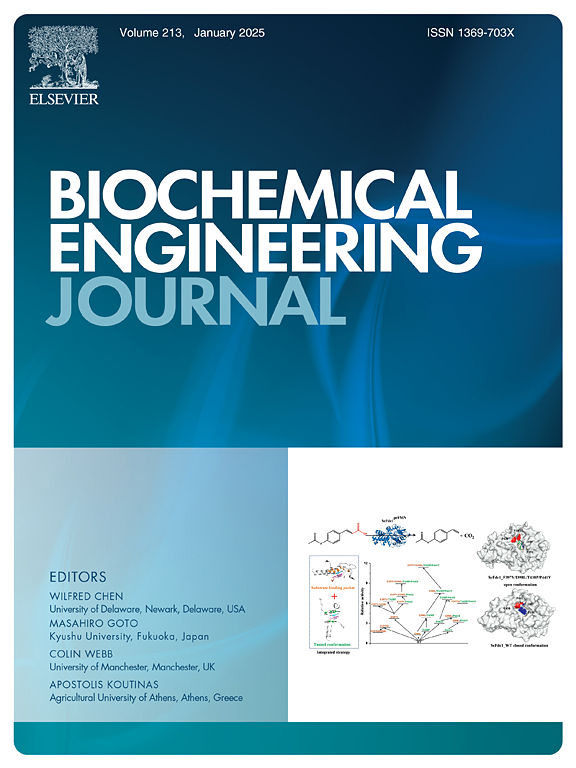Establishment of a denitrification phosphorus removal system under anaerobic-anoxic operation: Key factors, performance, and microbial community
IF 3.7
3区 生物学
Q2 BIOTECHNOLOGY & APPLIED MICROBIOLOGY
引用次数: 0
Abstract
Denitrification phosphorus removal (DPR) technology has received much attention due to its high utilisation of carbon sources, and the relative abundance of denitrifying phosphate accumulating organisms (DPAOs) and phosphate accumulating organisms (PAOs) as a percentage of a DPR system can significantly affect system performance. In this study, two sets of parallel sequencing batch reactors (SBR) were constructed and operated in anaerobic/anoxic (R1) and anaerobic/aerobic/anoxic (R2) modes to enrich DPR systems with different relative abundances of DPAOs, to investigate the interactions between DPAOs and PAOs when they coexist, and the effects of nitrate, carbon source, free ammonia (FA) key factors on the phosphorus removal performance of DPR systems. The findings indicated that R1 and R2 reached maximum phosphorus release at 1.0 mgFA/L and 0.6 mgFA/L, respectively. According to data from scanning electron microscopy and microbial high-throughput analysis, globular bacteria predominated on the surface of the granular sludge that developed, and there was a high relative abundance of DPAOs in R1. In addition to confirming the DPR system's operational effectiveness in both anaerobic/anoxic and anaerobic/aerobic/anoxic modes, as well as the associated genetic variations in nitrogen and phosphorus metabolism, and the optimal organic matter dosing concentration of 240 mg/L and the optimal nitrate (NO3-) concentration of 12 mg/L in the system prior to anoxia were derived for the DPR system.
厌氧-缺氧反硝化除磷系统的建立:关键因素、性能及微生物群落
反硝化除磷(DPR)技术因其对碳源的高利用率而受到广泛关注,而反硝化聚磷生物(DPAOs)和聚磷生物(PAOs)的相对丰度占DPR系统的百分比会显著影响系统的性能。本研究通过构建两套平行序批式反应器(SBR),在厌氧/缺氧(R1)和厌氧/好氧/缺氧(R2)模式下对不同相对丰度DPAOs的DPR系统进行富集,研究DPAOs与PAOs共存时的相互作用,以及硝酸盐、碳源、游离氨(FA)等关键因素对DPR系统除磷性能的影响。结果表明,R1和R2的最大磷释放量分别为1.0 mgFA/L和0.6 mgFA/L。扫描电镜和微生物高通量分析数据显示,形成的颗粒污泥表面以球状菌为主,R1中DPAOs相对丰度较高。除了证实了DPR系统在厌氧/缺氧和厌氧/好氧/缺氧两种模式下的运行有效性,以及相关的氮磷代谢遗传变异外,还得出了DPR系统在缺氧前的最佳有机物添加浓度为240 mg/L,硝酸盐(NO3-)的最佳浓度为12 mg/L。
本文章由计算机程序翻译,如有差异,请以英文原文为准。
求助全文
约1分钟内获得全文
求助全文
来源期刊

Biochemical Engineering Journal
工程技术-工程:化工
CiteScore
7.10
自引率
5.10%
发文量
380
审稿时长
34 days
期刊介绍:
The Biochemical Engineering Journal aims to promote progress in the crucial chemical engineering aspects of the development of biological processes associated with everything from raw materials preparation to product recovery relevant to industries as diverse as medical/healthcare, industrial biotechnology, and environmental biotechnology.
The Journal welcomes full length original research papers, short communications, and review papers* in the following research fields:
Biocatalysis (enzyme or microbial) and biotransformations, including immobilized biocatalyst preparation and kinetics
Biosensors and Biodevices including biofabrication and novel fuel cell development
Bioseparations including scale-up and protein refolding/renaturation
Environmental Bioengineering including bioconversion, bioremediation, and microbial fuel cells
Bioreactor Systems including characterization, optimization and scale-up
Bioresources and Biorefinery Engineering including biomass conversion, biofuels, bioenergy, and optimization
Industrial Biotechnology including specialty chemicals, platform chemicals and neutraceuticals
Biomaterials and Tissue Engineering including bioartificial organs, cell encapsulation, and controlled release
Cell Culture Engineering (plant, animal or insect cells) including viral vectors, monoclonal antibodies, recombinant proteins, vaccines, and secondary metabolites
Cell Therapies and Stem Cells including pluripotent, mesenchymal and hematopoietic stem cells; immunotherapies; tissue-specific differentiation; and cryopreservation
Metabolic Engineering, Systems and Synthetic Biology including OMICS, bioinformatics, in silico biology, and metabolic flux analysis
Protein Engineering including enzyme engineering and directed evolution.
 求助内容:
求助内容: 应助结果提醒方式:
应助结果提醒方式:


